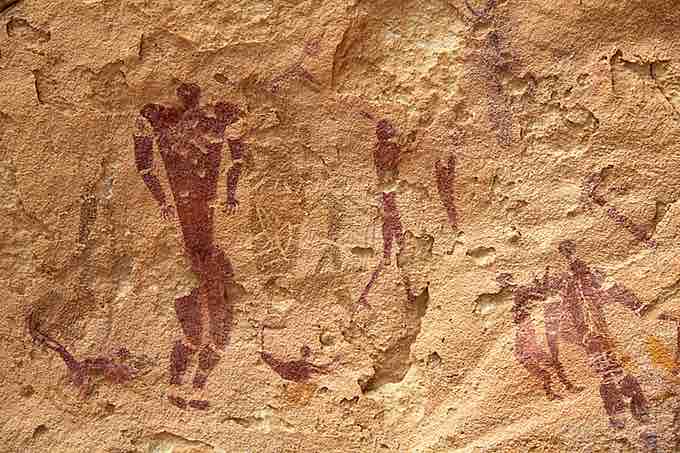Ancient rock and cave art can be found throughout the Sahara desert, providing a significant window into the art and culture of the prehistoric peoples of Africa. The Sahara, located in northern Africa, was the home of many complex human settlements dating from the Neolithic period. The region has a long history of climate change, and the desert area of today was once a savanna. Images carved and painted on natural rocks depict vibrant and vivid scenes from the Neolithic Subpluvial period. Most Saharan rock art dates to a period that climatologists call the Neolithic Subpluvial period. The Neolithic Subpluvial was the most recent of a number of periods of "Wet Sahara" or "Green Sahara," during which the Sahara region was much more moist and supported a richer biota and human population than the present-day desert.
Petroglyph at Balho, Djibouti
Djibouti lies on the eastern edge of the Sahara desert, which has not supported foliage-dependent animals like giraffes for approximately 10,000 years. This image informs us that the Sahara was once a grassland that contains plant life similar to that of modern sub-Saharan Africa.
The most common subjects depicted are hunting scenes, but others include animals, dancing, and people involved in everyday life. With the help of these pictographs and petroglyphs, archaeologists and scientists have begun to piece together information about the complex societies that once inhabited the region.
The Cave of the Swimmers
The Cave of Swimmers is among the most famous examples of rock art in the Sahara. Located in the mountainous Gilf Kebir plateau of the Libyan Desert, the cave and rock art was discovered in 1933 by the Hungarian explorer László Almásy. It contains Neolithic pictographs of people swimming that are estimated to have been created between 6,000 and 10,000 years ago, when wet climatic conditions maintained bodies of water deep enough for swimming and diving.

Cave of the Swimmers, Egypt
Painting of men in the Cave of the Swimmers, Wadi Sura, Gilf Kebir, Western Desert, Egypt
Tassili n'Ajjer
Tassili n'Ajjer is a mountain range in the Algerian section of the Sahara Desert. The range is noted for its prehistoric rock art depicting herds of cattle, large wild animals such as antelopes, and human activities such as hunting and dancing. The art has strong stylistic links to the pre-Nguni Art of South Africa and the region, executed in caves by the San Peoples before the year 1200 BCE. First discovered in 1933, more than 15,000 petroglyphs have been identified.
Sleeping antelope
Petroglyph depicting a possibly sleeping antelope, located at Tin Taghirt on the Tassili n’Ajjer in southern Algeria.
Hunters or pastoralists
Neolithic cave painting of either hunters or pastoralists during the Neolithic Subpluvial period. Tassil n'Ajjer (Plateau of the Chasms).
Jebel Uweinat
Jebel Uweinat is a large mountain made of granite and sandstone located at the triple borders of Libya, Egypt and Sudan. It harbors one of the richest concentrations of prehistoric rock art in the entire Sahara, mainly of the Neolithic cattle pastoralist cultures, but also a number of older paintings from hunter-gatherer societies.
Other important regions of rock art include: Tadrart Acacus, Libya; South Oran, Algeria; Tibesti, Chad; Mesak Settafet, Libya; Djelfa, Algeria; Ahaggar, Algeria; Draa River, Morocco; Figuig, Morocco; the Aïr Mountains, Niger, and throughout Mauritania. One petroglyph in Mauritania depicts pastoralists on horseback as they tend their livestock.
Livestock petroglyph
Petroglyph of bovine animals and abstract people on horseback. Mauritania.